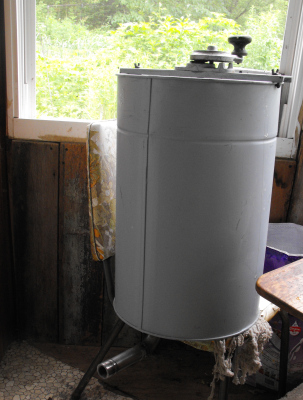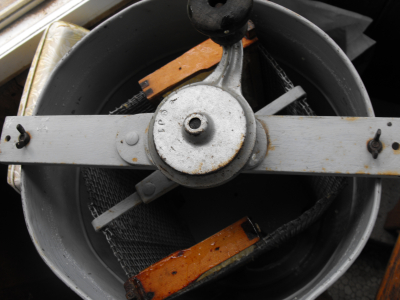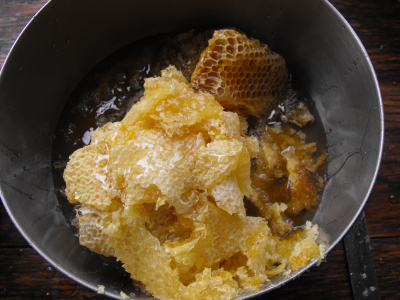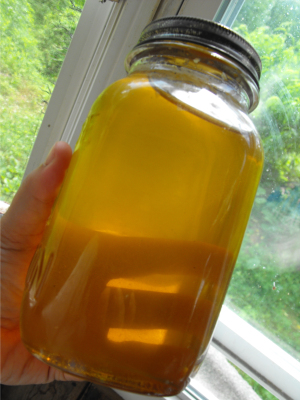
How to extract honey
 Although
I was running toward the trailer at top speed and swatting at my
breasts, I still had
the presence of mind to grab those two full frames
of honey. My beekeeping mentor (aka movie star neighbor)
had admonished me that, at this time of year, the frames need to go
back on
the hive ASAP. Within a couple of hours, he warned, bees will
start building comb willie nillie to fill that empty space. So,
even though I mostly felt like crawling into bed, I needed to extract
our honey and open the mean hive back up.
Although
I was running toward the trailer at top speed and swatting at my
breasts, I still had
the presence of mind to grab those two full frames
of honey. My beekeeping mentor (aka movie star neighbor)
had admonished me that, at this time of year, the frames need to go
back on
the hive ASAP. Within a couple of hours, he warned, bees will
start building comb willie nillie to fill that empty space. So,
even though I mostly felt like crawling into bed, I needed to extract
our honey and open the mean hive back up.
I iced my wounds, but my
head wasn't quite on
straight when I got to work on the honey. In fact, this post
really should be called "how to do everything wrong while extracting
honey." I hope you'll learn by seeing
the error of my ways.
Step
1: Remove the bees from the honey.
I actually managed to do this step well, moving the frames a good
distance from the hives (which calmed the bees down),
then gently brushing one frame at a time free of bees.
Step
2: Uncap the honey.
Here's where I failed miserably. For future reference, a plain
kitchen knife will mangle your comb so that it falls apart in the
extractor. A bread knife works great.
Step
3: Extract the comb honey. Place the cappings in a
collander on top of a bowl and mash the wax with a spoon to let the
honey begin to drain out.
 Step 4: Place a bowl under the spout at the
bottom of the extractor. With the state my head
was in, I'm surprised I remembered this step.
Step 4: Place a bowl under the spout at the
bottom of the extractor. With the state my head
was in, I'm surprised I remembered this step.
Step
5: Extract.
Place
the frames in the extractor opposite each other so that they are
balanced. With new comb like ours, it's best to gently spin the
extractor a few times, then flip the frames around and fully empty out
the other side of each frame, before flipping the frames a second time
and giving the handle a few hard spins. My beekeeping mentor
explained
this to me in great detail, but when I tried the gentle spin, I
couldn't see honey coming out (even though it was), so I spun
harder. As a result, the comb on my mangled frame from step 2
fell apart, and even the other frame got a bit distorted.
 Step 6: Cut out the mangled frame to join the
cappings.
Oops.
Step 6: Cut out the mangled frame to join the
cappings.
Oops.
Step
7: Put the frames back on the
angry, angry hive, along with an extra super since the bees are clearly
making honey faster than we can extract it. Your hive won't be
angry. Mine was because I made a mistake.
Step
8: Pour the honey from under the collander and from under the extractor
into canning jars for storage. No need to can ---
honey will keep indefinitely if harvested when fully capped and stored
in an  air-tight container.
Some people strain the honey first to remove the little bits of wax,
but I didn't bother.
air-tight container.
Some people strain the honey first to remove the little bits of wax,
but I didn't bother.
Step
9: Taste a bit of honey. It was all worth it!
I'm actually glad I
tried a couple of frames before embarking on a larger extracting
expedition. Now I'll know what I'm doing this week when we remove
a gallon (!!!) from the hive.
Want more in-depth information? Browse through our books.
Or explore more posts by date or by subject.
About us: Anna Hess and Mark Hamilton spent over a decade living self-sufficiently in the mountains of Virginia before moving north to start over from scratch in the foothills of Ohio. They've experimented with permaculture, no-till gardening, trailersteading, home-based microbusinesses and much more, writing about their adventures in both blogs and books.
Want to be notified when new comments are posted on this page? Click on the RSS button after you add a comment to subscribe to the comment feed, or simply check the box beside "email replies to me" while writing your comment.
- Remove comment
- Remove comment
